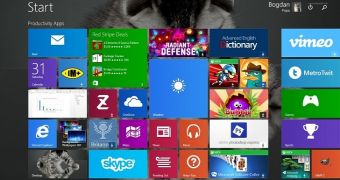Back in October 2012, Microsoft introduced a completely new operating system that came not only with a refreshed interface, but also with a Modern UI that was entirely based on the Start screen.
Very controversial at first, the Start screen was, is, and will remain the essence of the Metro UI, as it provides instant access to all Windows Store apps, while also allowing users to quickly search online and offline and even access specific system features by simply typing their names.
The Start screen received several improvements since its original launch, and users no longer need to see it at boot if they don't want to, but there was a time when no other option was available.
In Windows 8, for example, the computer booted straight to the Start screen, so everyone had to view all tiles, click on “desktop” and only then start working on their PCs. Microsoft adjusted this configuration in Windows 8.1 and offered users a boot to desktop option that basically allowed them to skip the Start screen and get straight to the desktop when starting up their computers.
Similar features were already available in third-party applications specifically developed for Windows 8, so, given their popularity, it's no surprise that Redmond itself decided to offer its users such an option.
But why wasn't the boot to desktop option offered to users from the very beginning? For a company as large as Microsoft, it's hard to believe that no one actually thought about giving users the power of choice and let them decide whether they want to see the Start screen at boot or not.
In fact, Microsoft made the right choice to get everyone to the Start screen and here's why.
First of all, I'm pretty sure that Microsoft was well aware that Windows 8 comes with pretty significant changes in terms of looks and usability as compared to its predecessors, so the company more or less expected the avalanche of criticism that it had to face after the October 2012 launch.
The Start screen replaces the much more familiar Start menu, and, since users do not really like changes, the new touch-optimized feature wasn't so well received as some might have expected.
As a result, Microsoft took the risk of offering the Start screen to absolutely all those who installed Windows 8, even though it was very clear that some might like it, but many might not.
Second of all, Microsoft had to make people aware that the Start screen was there. If the company had decided to make it optional and let users disable it from the very beginning, many would have only tried it once and then disabled it forever. After a few months, nobody would have even discussed about the Start screen, which wasn't quite the thing that Microsoft aimed for.
At this point, everyone knows that the Start screen is a key feature of Windows 8 and 8.1, no matter if it's good or bad. It's up to each of us to decide it, but at least we know it's there.
Microsoft itself admitted that it had to push the Start screen to everyone to make sure that new Windows 8 users had a look at it and tried out its features before eventually choosing whether to keep or disable it. Now that pretty much everybody knows that a Start screen is the core of the Modern UI, the company can start tweaking this feature in order to make it appropriate for all computers.
And that's exactly what the software giant is doing right now.
In Windows 8.1, Microsoft finally implemented the boot to desktop option I was talking about, thus giving users the power to go directly to the desktop when starting their PCs. At the same time, it also introduced new features that allowed adopters to use the desktop wallpaper as the Start screen background, as a way to make the transition between the desktop and Metro easier.
Newly installed apps no longer show up on the Start screen in order to keep things organized. More tile sizes were introduced, and so was an option to access the “All Apps” view whenever you go to the Start screen.
In Windows 8.1 Update, Microsoft went even further and brought context menus on the Start screen, giving mouse users more control over their tiles. The taskbar is now being displayed no matter if you're on the Start screen or in a Metro app, again with the purpose of making the switch from the Modern UI to the desktop faster.
Again, Microsoft seems to have made the right call.
It's hard to predict whether the Start screen would finally be adopted by all those running modern Windows or not, since Microsoft is working to bring back the Start menu in a future update, but at least we know it's there, we know how it works and we know that, on touch-capable devices, it's a really awesome feature.
In the end, one question remains: who needs a Start menu anymore?

 14 DAY TRIAL //
14 DAY TRIAL //